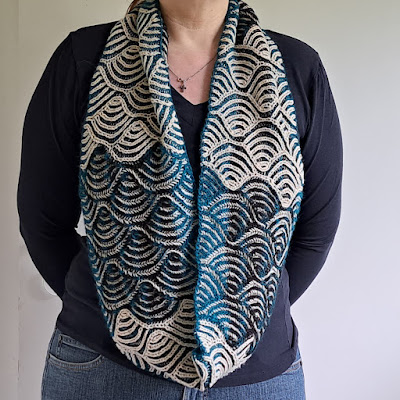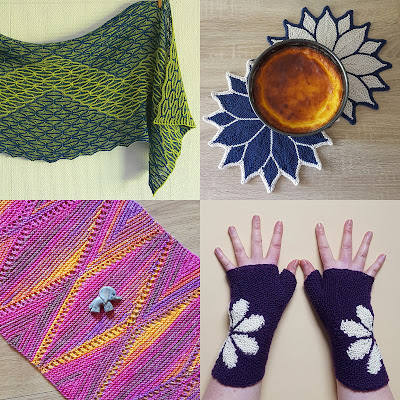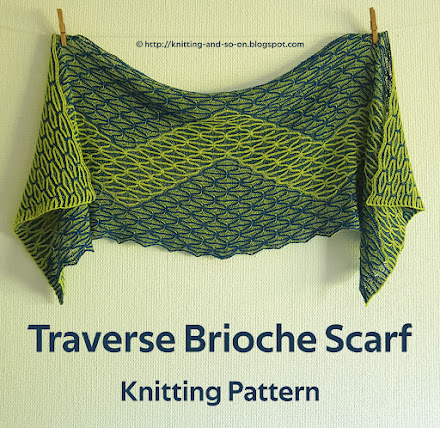Und hier ist die Strickanleitung für diese Mütze, die wir auf Deutsch "Wendepunkt-Mütze" genannt haben.
Diese Mütze wird in offener Arbeit hin und her gestrickt und kommt vollständig ohne verkürzte Reihen aus. Man startet mit einem sogenannten “magischen Maschenanschlag” von einer Seite des Kopfes, strickt Zunahmen bis zur Mitte, nimmt anschließend Maschen ab und beendet mit einem “Abketten mit drei Nadeln”.
Die fertige Mütze hat etwa die Grösse S-M, d.h. sie hat einen Umfang von ca. 50 cm (am Bündchen) und ist flach ausgelegt 23 cm hoch. Das Bündchen ist aber sehr elastisch und kann bequem bis zu 56 cm gestreckt werden.
Ja, hier braucht man leider eine Maschenprobe - und es ist auch ratsam den Kopf des vorgesehenen Trägers zu messen.
Anleitung
Magischer Maschenanschlag: 2x15 Maschen, d.h. auf jeder Nadel sind 15 Maschen.
Das Strickstück sieht nun aus wie auf Bild A.
Nun die Nadeln so drehen, dass die Krausrippe vorne sichtbar ist. Alle Reihen werden nun in einer U-Form gestrickt, d.h. erst werden die Maschen auf der oberen Nadel abgestrickt, dann wird das Strickstück gedreht (so dass oben und unten vertauscht werden) und anschließend die Maschen der zweiten Nadel abgestrickt.
Der Punkt, an dem die Drehung stattfindet, wird Wendepunkt (“WP”) genannt.
Zuerst werden vier Zunahmen pro Hinreihe gestrickt.
Reihe 1 (RR): 18 Mre, Maschenmarkierer platzieren, 2 Mli, WP, 2Mi, Maschenmarkierer platzieren, 18 Mre - die Maschenmarkierer trennen den kraus-rechts Teil (Bündchen) vom glatt-rechts Teil (oberer Teil der Mütze)
Reihe 2 (HR): 1 M abh, 17 Mre, MM, [kfb]*4, MM, 18 Mre - das Strickstück sieht jetzt aus wie in Illustration 1, die U-Form ist noch nicht ganz sichtbar
Reihe 3 und alle weiteren ungeraden Reihen: 1 M abh, Mre bis MM, MM, Mli bis zum nächsten MM, MM, Mre bis Ende
Reihe 4 (HR): 1 M abh., 17 Mre, [1 Mre, kfb]*4, 18 Mre
Reihe 6 (HR): 1 M abh., 17 Mre, [kfb, 2 Mre]*4, 18 Mre
Reihe 8 (HR): 1 M abh., 17 Mre, [k2, kfb, 1 Mre]*4, 18 Mre
Reihe 10 (HR): 1 M abh., 17 Mre, [1 Mre, kfb, 3 Mre]*4, 18 Mre
Reihe 12 (HR): 1 M abh., 17 Mre, [4 Mre, kfb, 1 Mre]*4, 18 Mre
Reihe 14 (HR): 1 M abh., 17 Mre, [kfb, 6 Mre]*4, 18 Mre
Reihe 16 (HR): 1 M abh., 17 Mre, [4 Mre, kfb, 3 Mre]*4, 18 Mre
Das Strickstück sieht nun in etwa so aus wie auf Bild B.
Ab jetzt werden jeweils 3 Zunahmen pro Hinreihe gestrickt.
Reihe 18 (HR): 1 M abh., 17 Mre, [6 Mre, kfb, 5 Mre]*3, 18 Mre
Reihe 20 (HR): 1 M abh., 17 Mre, [2 Mre, kfb, 10 Mre]*3, 18 Mre
Reihe 22 (HR): 1 M abh., 17 Mre, [10 Mre, kfb, 3 Mre]*3, 18 Mre
Reihe 24 (HR): 1 M abh., 17 Mre, [1 Mre, kfb, 13 Mre]*3, 18 Mre
Reihe 26 (HR): 1 M abh., 17 Mre, [11 Mre, kfb, 4 Mre]*3, 18 Mre
Reihe 28 (HR): 1 M abh., 17 Mre, [5 Mre, kfb, 11 Mre]*3, 18 Mre
Reihe 30 (HR): 1 M abh., 17 Mre, [13 Mre, kfb, 4 Mre]*3, 18 Mre
Reihe 32 (HR): 1 M abh., 17 Mre, [Mre 2, kfb, 16 Mre]*3, 18 Mre
Das Strickstück sieht nun in etwa so aus wie auf Bild C.
Je nachdem wie lange die verwendete Rundstricknadel ist, nun von der Magic Loop Methode zum normalen Stricken wechseln, d.h. ohne dass ein Teil des Seiles heraussteht. Um das Zählen zu erleichtern, ist es ratsam, an die Stelle des WPs einen weiteren Maschenmarkierer einzufügen.
Ab jetzt werden pro Hinreihe 2 Zunahmen gestrickt.
Reihe 34 (HR): 1 M abh., 17 Mre, [20 Mre, kfb, 9 Mre]*2, 18 Mre
Reihe 36 (HR): 1 M abh., 17 Mre, [2 Mre, kfb, 28 Mre]*2, 18 Mre
Reihe 38 (HR): 1 M abh., 17 Mre, [10 Mre, kfb, 21 Mre]*2, 18 Mre
Reihe 40 (HR): 1 M abh., 17 Mre, [25 Mre, kfb, 7 Mre]*2, 18 Mre
Reihe 42 (HR): 1 M abh., 17 Mre, [13 Mre, kfb, 20 Mre]*2, 18 Mre
Das Strickstück sieht nun so aus wie auf Bild D.
Ab jetzt wird in jeder Hinreihe jetzt nur noch eine Masche zugenommen.
Reihe 44 (HR): 1 M abh., 17 Mre, 27 Mre, kfb, Mre bis MM, 18 Mre
Reihe 45 (RR): 1 M abh., 17 Mre, Mli bis MM (d.h. 71 Mli), 18 Mre
Reihe 46 (HR): 1 M abh., 17 Mre, 53 Mre, kfb, Mre bis MM, 18 Mre
Reihe 48 (HR): 1 M abh., 17 Mre, 32 Mre, kfb, Mre bis MM, 18 Mre
Reihe 50 (HR): 1 M abh., 17 Mre, 39 Mre, kfb,Mre bis MM, 18 Mre
Nun folgen die Reihen ohne Zu- oder Abnahmen.
Reihe 52 (HR): 1 M abh., Mre bis zum Ende
Das Bündchen (Krausrippen am unteren Rand) sollte jetzt (leicht gestreckt) so lange sein wie die Hälfte des Kopfumfanges.
Reihe 54 (HR): 1 M abh., Mre bis zum Ende
Jeweils eine Abnahme pro Hinreihe.
Reihe 56 (HR): 1 M abh., 17 Mre, 38 Mre, ssk, Mre bis MM, 18 Mre
Reihe 58 (HR): 1 M abh., 17 Mre, 31 Mre, ssk, Mre bis MM, 18 Mre
Reihe 60 (HR): 1 M abh., 17 Mre, 52 Mre, ssk, Mre bis MM, 18 Mre
Reihe 62 (HR): 1 M abh., 17 Mre, 26 Mre, ssk, Mre bis MM, 18 Mre
In diesem Teil werden 2 Abnahmen pro Hinreihe gestrickt.
Reihe 64 (HR): 1 M abh., 17 Mre, [13 Mre, ssk, 20 Mre]*2, 18 Mre
Reihe 66 (HR): 1 M abh., 17 Mre, [25 Mre, ssk, 7 Mre]*2, 18 Mre
Reihe 68 (HR): 1 M abh., 17 Mre, [10 Mre, ssk, 21 Mre]*2, 18 Mre
Reihe 70 (HR): 1 M abh., 17 Mre, [2 Mre, ssk, 29 Mre]*2, 18 Mre
Reihe 72 (HR): 1 M abh., 17 Mre, [20 Mre, ssk, 9 Mre]*2, 18 Mre
Pro Hinreihe werden nun drei Maschen abgenommen.
Reihe 74 (HR): 1 M abh., 17 Mre, [2 Mre, ssk, 16 Mre]*3, 18 Mre
Reihe 76 (HR): 1 M abh., 17 Mre, [13 Mre, ssk, 4 Mre]*3, 18 Mre
Reihe 78 (HR): 1 M abh., 17 Mre, [5 Mre, ssk, 11 Mre]*3, 18 Mre
Reihe 80 (HR): 1 M abh., 17 Mre, [11 Mre, ssk, 4 Mre]*3, 18 Mre
Reihe 82 (HR): 1 M abh., 17 Mre, [1 Mre, ssk, 13 Mre]*3, 18 Mre
Reihe 84 (HR): 1 M abh., 17 Mre, [10 Mre, ssk, 3 Mre]*3, 18 Mre
Reihe 86 (HR): 1 M abh., 17 Mre, [2 Mre, ssk, 10 Mre]*3, 18 Mre
Reihe 88 (HR): 1 M abh., 17 Mre, [6 Mre, ssk, 5 Mre]*3, 18 Mre
Und schliesslich vier Abnahmen pro Hinreihe.
Reihe 90 (HR): 1 M abh., 17 Mre, [4 Mre, ssk, 3 Mre]*4, 18 Mre
Reihe 92 (HR): 1 M abh., 17 Mre, [6 Mre, ssk]*4, 18 Mre
Reihe 94 (HR): 1 M abh., 17 Mre, [4 Mre, ssk, 1 Mre]*4, 18 Mre
Reihe 96 (HR): 1 M abh., 17 Mre, [1 Mre, ssk, 3 Mre]*4, 18 Mre
Reihe 98 (HR): 1 M abh., 17 Mre, [2 Mre, ssk, 1 Mre]*4, 18 Mre
Reihe 100 (HR): 1 M abh., 17 Mre, [ssk, 2 Mre]*4, 18 Mre
Reihe 102 (HR): 1 M abh., 17 Mre, [1 Mre, ssk]*3, k1, 2 M re. zus., 18 Mre -
(Die letzte Abnahme wurde als rechtsgeneigt zusammengestrickt, weil dies einen schöneren Übergang zum Kraus-Rechts-Bündchen bildet.
Reihe 104 (HR): 1 M abh., 17 Mre, [ssk]*3, 2 M re. zus., 18 Mre
Reihe 105 (RR) = Reihe 3
Das Strickstück sieht nun in etwa aus wie auf Bild E.

Nach Beendigung der letzten Reihe sollte wieder dieselbe Anzahl Maschen vorhanden sein, wie ganz am Anfang nach dem Maschenanschlag (d.h. 2 x 20 Maschen).
Die Mütze nun auf links drehen, die beiden Seiten zusammenhalten und mit dem Abketten mit drei Nadeln zusammenstricken.
Nach dem Vernähen der Enden ist die Mütze fertig und zurück auf rechts gedreht werden.













































